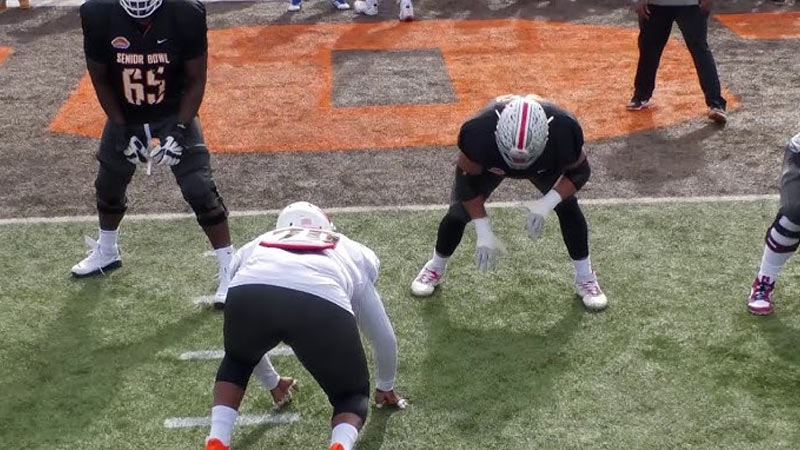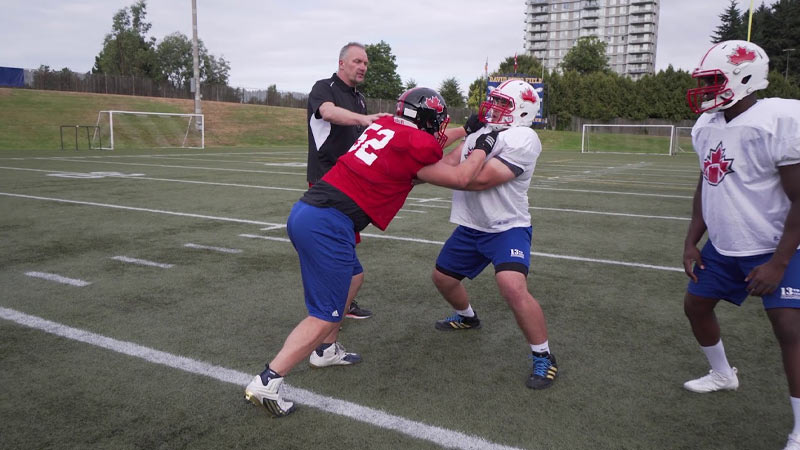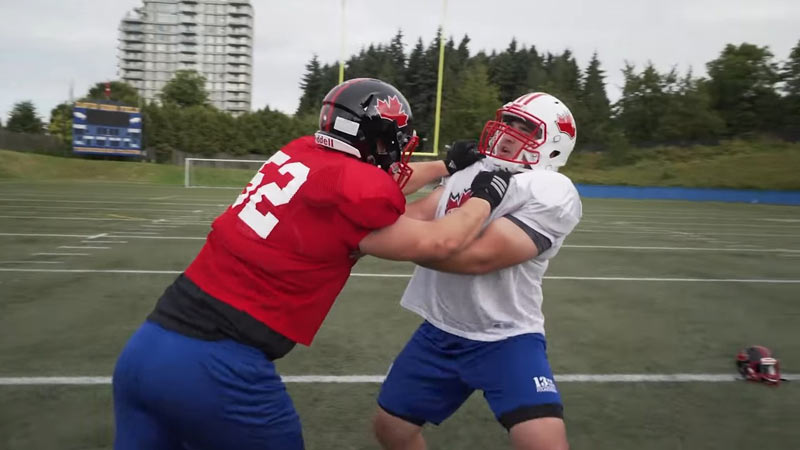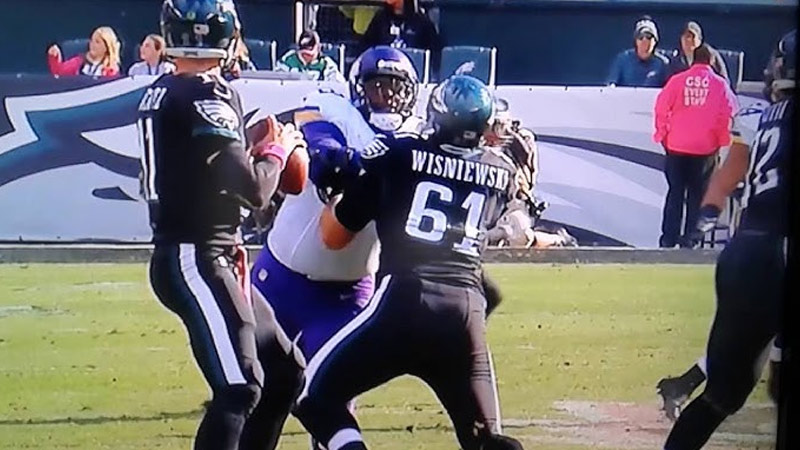In the intense battlefield of American football, the football bull rush stands as a formidable pass-rushing technique utilized by defensive linemen to disrupt the offensive line and reach the quarterback.
This aggressive and powerful move involves driving forward with unyielding force to overpower offensive linemen, creating chaos in the pocket and forcing hurried decisions.
Executing a successful bull rush demands a blend of raw strength, precise timing, and relentless determination. The technique’s effectiveness lies in its ability to collapse the pocket, disturb the quarterback’s rhythm, and potentially lead to game-changing turnovers.
Defensive linemen who excel in the bull rush become a dominant force on the field, leaving an indelible mark on every snap.
In this high-stakes game of inches, the football bull rush emerges as a pivotal tactic, embodying the essence of strategic warfare on the gridiron.
What is Football Bull Rush?
In football, the bull rush is a powerful and aggressive pass-rushing technique employed by defensive linemen to overpower offensive linemen and reach the quarterback.
When executing a bull rush, the defensive player aligns directly in front of the offensive lineman and drives forward with incredible force.
The goal is to use sheer strength, leverage, and relentless pressure to push the offensive lineman backwards and collapse the pocket.
This technique is highly effective when the defensive lineman possesses superior strength and lower body power.
By consistently driving the offensive lineman backwards, the bull rush disrupts the quarterback’s timing and forces them to make hurried decisions, leading to potential sacks, hurried throws, or turnovers.
However, successful execution requires proper timing and positioning to avoid getting off-balance or neutralized by the offensive lineman’s counter moves. Coaches emphasize the bull rush as a valuable tool in a pass-rusher’s arsenal, and players who excel in this technique can become menacing forces on the defensive line.
How to Perform Football Bull Rush?

Performing a football bull rush requires a combination of strength, technique, and timing to overpower the offensive lineman effectively.
Here are the key steps to execute a successful bull rush:
Get into a Solid Stance
Start by getting into a low and balanced stance with your feet shoulder-width apart. Bend your knees and keep your back straight to generate maximum power from your lower body.
Engage with the Offensive Lineman
At the snap of the ball, explode off the line and drive forward with explosive power. Extend your arms forcefully to gain leverage on the offensive lineman, keeping your hands inside their shoulder pads.
Use Proper Hand Placement
Place your hands on the offensive lineman’s chest or shoulders, keeping them high and tight to control the engagement. Aim to get under the offensive lineman’s pads to lift them up and gain an advantage.
Drive with Power and Leverage
Utilize your lower body strength to drive the offensive lineman backwards. Keep your feet moving and maintain a low centre of gravity to maximize leverage and push.
Stay Balanced and Stay Focused
As you push forward, be aware of maintaining your balance and not getting overextended. Keep your eyes on the quarterback and be prepared to react to any counter moves from the offensive lineman.
Transition to Disengagement
Once you’ve driven the offensive lineman backwards, be ready to disengage and shed their block quickly. You can use a quick swipe or rip move with your hands to free yourself and continue your pursuit of the quarterback.
Time Your Rush
The timing of the bull rush is crucial. Wait for the snap count and watch the offensive lineman’s initial movements to anticipate their actions. If you rush too early or too late, it can diminish the effectiveness of your bull rush.
Practice and Repetition
Like any football technique, mastering the bull rush requires practice and repetition. Work on your hand placement, footwork, and timing during individual drills and one-on-one sessions with offensive linemen.
By mastering the football bull rush, defensive linemen can become formidable pass rushers, disrupting quarterbacks’ rhythm and creating opportunities for sacks and turnovers.
However, it is essential to combine the bull rush with other pass-rushing moves to keep offensive linemen guessing and maintain a versatile approach to getting to the quarterback.
How Do You Stop A Bull Rush In Football?

Stopping a bull rush in football requires offensive linemen to be technically sound, maintain proper positioning, and use effective counter techniques to neutralize the defensive lineman’s power and force. Here are the key steps to stop a bull rush:
Maintain a Strong Base
Offensive linemen must start in a low and balanced stance with their feet shoulder-width apart. Keeping a strong base allows them to absorb the initial impact and anchor against the bull rush.
Use Proper Hand Placement
Offensive linemen should aim to get their hands inside the defensive lineman’s shoulder pads and maintain control of the engagement. This helps prevent the defender from gaining leverage and driving them backwards.
Sink Hips and Bend Knees
As the defensive lineman engages with the bull rush, offensive linemen must sink their hips and bend their knees to maintain a low centre of gravity. This prevents them from being lifted off the ground and losing balance.
Establish and Maintain Hand fighting
Offensive linemen should use quick and powerful hand strikes to disrupt the defensive lineman’s bull rush. Handfighting involves swiping away the defender’s hands and redirecting their momentum, preventing them from gaining traction.
Anchor and Brace for Impact
Offensive linemen need to brace themselves for the initial impact of the bull rush. By maintaining a strong anchor with their feet and absorbing the force with their legs and core, they can resist the push and prevent being driven backwards.
React and Adjust
As the bull rush progresses, offensive linemen must be prepared to react to any counter moves from the defender. They can use the defender’s momentum against them and redirect their rush away from the quarterback.
Work as a Unit
Offensive linemen must communicate and work together as a cohesive unit to handle the bull rush effectively. Helping each other with double-team blocks or combination blocks can deter the defender’s rush and provide additional support.
Study the Defender’s Tendencies:
Understanding the defender’s tendencies and pass-rushing moves can give offensive linemen an advantage. By studying film and recognizing patterns, they can anticipate the bull rush and adjust their techniques accordingly.
By effectively countering the bull rush, offensive linemen can protect the quarterback and keep the pocket intact.
Combining sound technique, teamwork, and adaptability can frustrate the defender’s rush and neutralize their impact on the game.
Continuous practice and improvement in pass protection are essential for offensive linemen to become adept at stopping the bull rush and maintaining a strong offensive line.
What Players Are Part Of A Bull Rush?

Here are some descriptions of what players are part of a bull rush-
Defensive Linemen:
Defensive linemen are the primary players known for utilizing the bull rush technique. These players, including defensive ends and defensive tackles, use their size, strength, and power to overpower offensive linemen and disrupt the passing game.
Defensive linemen with exceptional bull rush skills become menacing forces on the field, applying consistent pressure on the quarterback and forcing hurried throws.
Offensive Linemen:
On the other side of the line, offensive linemen play a crucial role in countering the bull rush. They must possess solid technique, strength, and balance to anchor against the force of the bull rush.
Offensive tackles, guards, and centres work together as a unit to protect the quarterback and prevent the defensive lineman from penetrating the pocket.
Quarterback:
The quarterback is also involved in the bull rush dynamic. A skilled quarterback reads the defensive alignment, identifies the potential bull rusher, and adjusts the offensive protection scheme accordingly.
They must remain composed under pressure and quickly release the ball to avoid sacks when facing a formidable bull rush.
Tight Ends and Running Backs:
Tight ends and running backs may also be part of the bull rush equation, especially in pass protection.
In certain offensive schemes, tight ends are tasked with assisting offensive tackles in blocking the bull rusher, while running backs might be responsible for picking up blitzing defensive linemen to protect the quarterback.
Coaches and Strategists:
Coaches play a significant role in developing players’ bull rush techniques. Defensive line coaches teach the bull rush to their linemen, emphasizing the proper stance, hand placement, and leverage.
Offensive line coaches work with their players to counter the bull rush effectively, focusing on footwork, hand fighting, and recognition of defensive tendencies.
In the dynamic interplay of the bull rush, multiple players contribute to the outcome of each pass-rushing scenario.
Defensive linemen seek to overpower their opponents, while offensive linemen aim to withstand the force.
Quarterbacks, tight ends, and running backs play pivotal roles in protecting the pocket and ensuring successful passing plays.
Coaches and strategists shape the development and execution of the bull rush, making it a critical aspect of football strategy and skill on both sides of the ball.
FAQ
Q: What is a football bull rush?
A: The football bull rush is a pass-rushing technique employed by defensive linemen to overpower offensive linemen and reach the quarterback. It involves driving forward with force and power, using sheer strength and leverage to collapse the pocket and disrupt the quarterback’s timing.
Q: How do defensive linemen execute the bull rush effectively?
A: To execute the bull rush, defensive linemen must start in a low and balanced stance, explode off the line of scrimmage, and engage the offensive lineman with proper hand placement. They use their lower body strength to drive forward, keeping their feet moving and maintaining a low centre of gravity to maximize leverage.
Q: What can offensive linemen do to counter the bull rush?
A: Offensive linemen can counter the bull rush by maintaining a strong base, using proper hand placement, and sinking their hips to prevent being lifted off the ground. They must also engage in hand fighting to disrupt the defensive lineman’s bull rush and maintain control of the engagement.
Q: Is the bull rush effective against all types of quarterbacks?
A: The bull rush can be effective against various quarterbacks, but its success may vary based on the quarterback’s mobility, awareness, and ability to release the ball quickly.
Q: Are there any risks associated with using the bull rush?
A: While the bull rush is a potent pass-rushing technique, it carries some risks. If not executed properly, defensive linemen can become off-balance or neutralized by skilled offensive linemen.
Wrapping up
In the unforgiving world of American football, the bull rush remains an indispensable weapon for defensive linemen seeking to impose their will on the game.
The relentless charge and unwavering determination of a well-executed bull rush can disrupt offensive plays, dictate the course of a game, and intimidate even the most composed quarterbacks.
As the epitome of power and tenacity on the defensive front, the football bull rush epitomizes the essence of physicality and strategy in the sport. Its effectiveness hinges on the delicate balance of strength, technique, and timing, making it a formidable challenge for offensive linemen to counter.
Football’s ongoing evolution demands players and coaches to continually refine and adapt their bull rush tactics, ensuring its lasting prominence as a game-changing element that leaves an indelible mark on the gridiron.







